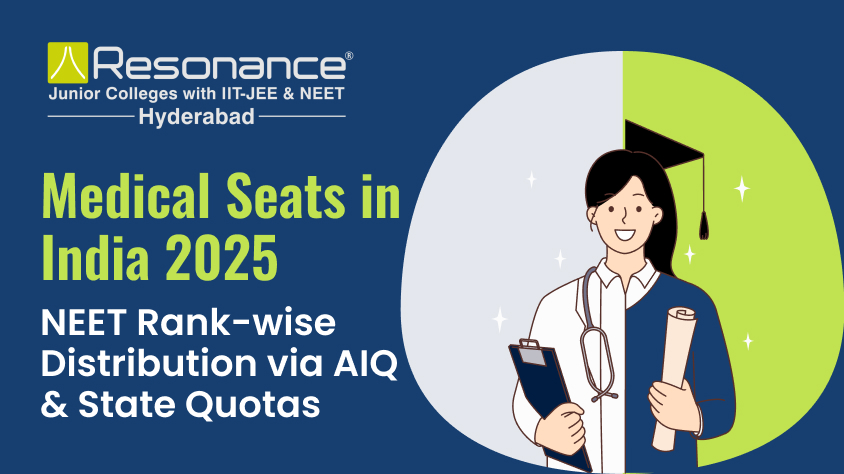- Resonance
- 319 Views
Medical Seats 2025: NEET Rank-based AIQ & State Quota Allocation

The Medical Counselling Committee (MCC) is the governing body that issues guidelines on medical exams conducted at the national level. The National Testing Agency (NTA) monitors the National Eligibility Entrance Test (NEET), evaluates performances, and ensures that rank holders secure admissions at the respective medical institutions at the central and state levels. The Government of India has reserved 15 percent of NEET seats under the All India Quota, and the MCC fills the 15 percent seats throughout India in the state-level colleges. The remaining 85 percent of NEET seats that are allotted at the state level are filled by the respective states. 100 percent of the NEET seats are filled in medical colleges at both the central and state levels through four rounds. Therefore, when NEET counselling begins, it is conducted simultaneously at the central and state levels. NTA publishes a strict schedule, and each round is contested by the participating NEET scorers for seat accommodation at the best medical colleges made available. At the end of each round, a candidate can cancel their locked seat and attempt the next scheduled round. The registration fee and any additional collected fees are adjusted for the subsequent rounds. However, one must stay updated on the number of available medical seats in India at the state and central levels. The lines below describe the composition of seat availability at reputed government colleges at the state & central levels, including the autonomous universities, which means total MBBS seats in India. This information can become a reference for those attending the NEET counselling sessions.
Medical Seats in India for 2025: A broader Spectrum
Over the years, under the direction of the Government of India, the National Medical Commission (NMC) safeguards the interests of NEET achievers in allocating the medical seats in India. It keeps track of seat allocation in AIQ (15%) government colleges and the state quota ( 85%) government medical colleges. In a way, NMC designs the medical policies that enhance medical education in India.
In India, the medical profession has taken a sharp rise, with as many as 700+ medical colleges, and 1,08,000 seats. 50 percent of the seats are reserved for government medical colleges at the central and state levels; the remaining seats are reserved for private institutions. According to the Medical National Commission ( MNC), NEET seats are shared by central and state-level colleges.
The central medical colleges include central universities, deemed universities, and the Centre-funded institutions such as the All India Institute of Medical Sciences, AIIMS, at different locations in India. These government medical colleges fill in the seats through the NEET scores only.
NEET rank holders are allotted to the state medical colleges in two phases. 15 percent of the NEET rank holders are allotted across all states. It is known as the All India quota - 15%, while the remaining seats of 85 percent are filled by the respective states.
Way back in 2017, 65,000 medical seats in India were allotted, and now they have increased to 1,08,000. This rise in the medical seats is an indication of the rising number of medical seat aspirants. The government is providing students with medical education at an affordable price.
State-wise NEET 2025 Seat allocations from the total MBBS Seats in India
National Medical Commission directs the Medical Counselling Committee, MCC, wherein 59,416 government MBBS seats are filled based on the NEET 2025 exam from the total MBBS seats in India. The Excel sheet below is the fact sheet of State-wise NEET seat allocations.
State-Wise Distribution of Government Colleges Across the Nation
State-wise Distribution of Government Colleges | Column1 | Column2 |
State-wise Distribution of Total MBBS | Government Colleges | Seat Allotment |
Andaman & Nicobar Islands | 1 | 114 |
Andhra Pradesh | 18 | 3235 |
Arunachal Pradesh | 1 | 50 |
Assam | 3 | 1550 |
Bihar | 13 | 1615 |
Chandigarh | 1 | 150 |
Chhattisgarh | 10 | 1385 |
Dadra & Nagar Haveli | 1 | 177 |
Delhi | 8 | 1247 |
Goa | 1 | 180 |
Gujarat | 23 | 4250 |
Haryana | 7 | 835 |
Himachal Pradesh | 7 | 770 |
Jammu & Kashmir | 11 | 1239 |
Jharkhand | 7 | 805 |
Karnataka | 22 | 3450 |
Kerala | 12 | 1755 |
Madhya Pradesh | 15 | 2400 |
Maharashtra | 32 | 5125 |
Manipur | 2 | 375 |
Meghalaya | 1 | 50 |
Mizoram | 1 | 100 |
Nagaland | 1 | 100 |
Orissa | 12 | 1675 |
Puducherry | 2 | 380 |
Punjab | 5 | 850 |
Rajasthan | 26 | 3825 |
Tamil Nadu | 38 | 5990 |
Telangana | 28 | 3890 |
Tripura | 1 | 125 |
Uttar Pradesh | 35 | 4303 |
Uttarakhand | 3 | 375 |
West Bengal | 26 | 3825 |
The tabulation represents the total NEET seats allotted for States across the nation. The first column describes the state across the country, the second and third column narrates government colleges and the total number of seats accordingly. Below is the graphical representation of two parameters along the x-axis (states) and the Y-axis (total number of government seats). The second consecutive graph represents the states along the x-axis and the total number of colleges across the Y-axis.
State-wise Distribution of Government Seats for the All India Quota ( 15%)
Column1 | Column2 | Column3 |
NEET 2025: Government MBBS Seats For AIQ Through NEET | ||
|
| |
State | Govt. Colleges | Govt. Seats |
Andaman & Nicobar | 1 | 15 |
Andhra Pradesh | 12 | 285 |
Assam | 6 | 108 |
Bihar | 9 | 142 |
Chandigarh | 1 | 15 |
Chhattisgarh | 5 | 81 |
Delhi | 6 | 135 |
Goa | 1 | 22 |
Gujarat | 6 | 161 |
Haryana | 5 | 88 |
Himachal Pradesh | 3 | 18 |
Jharkhand | 3 | 45 |
Karnataka | 18 | 412 |
Kerala | 9 | 194 |
Madhya Pradesh | 6 | 126 |
Maharashtra | 16 | 443 |
Manipur | 2 | 30 |
Meghalaya | 1 | 18 |
Orissa | 3 | 126 |
Puducherry | 1 | 22 |
Punjab | 3 | 78 |
Rajasthan | 8 | 220 |
Tamil Nadu | 24 | 471 |
Telangana | 7 | 165 |
Tripura | 1 | 18 |
Uttar Pradesh | 13 | 288 |
Uttarakhand | 3 | 36 |
West Bengal | 14 | 324 |
Total | 192 | 4,129 |
The tabulation represents the NEET seats allotted for States across the nation through All India Quota ( AIQ)-15%. The first column describes the state across the country, the second and third column narrates government colleges and the total number of seats accordingly. Below is the graphical representation of two parameters along the x-axis (states) and the Y-axis (total number of government colleges). The second consecutive graph represents the states along the Y-axis and the total number of colleges across the X-axis.
Yearly State-wise Allocation of All India Quota (15%)
Yearly State-wise Allocation - NEET (15%) | Column1 |
Yearly | Total Number of Students ( NEET 15%) |
2018-19 | 33,893 |
2019-20 | 42,222 |
2020-21 | 49,435 |
2022-23 | 48,212 |
2023-24 | 55,880 |
2024-25 | 55,688 |
The tabulation above describes the columnwise data of years and the total number of seats allotted under the AIQ. Further, the graphical representation is the years described along the Y-axis and the number of seats described along the X-axis.
State-wise Distribution of 85% Government Seats by the Respective States Across India
States | Govt. Colleges | Total Seats |
Andaman & Nicobar | 1 | 85 |
Andhra Pradesh | 12 | 1,016 |
Assam | 6 | 612 |
Bihar | 9 | 895 |
Chandigarh | 1 | 125 |
Chhattisgarh | 5 | 459 |
Delhi | 6 | 247 |
Goa | 1 | 121 |
Gujarat | 6 | 926 |
Haryana | 5 | 495 |
Himachal Pradesh | 3 | 225 |
Jammu & Kashmir | 3 | 409 |
Jharkhand | 3 | 170 |
Karnataka | 18 | 2,335 |
Kerala | 9 | 1,029 |
Madhya Pradesh | 6 | 981 |
Maharashtra | 16 | 2,038 |
Manipur | 2 | 170 |
Meghalaya | 1 | 125 |
Orissa | 3 | 424 |
Puducherry | 1 | 121 |
Punjab | 3 | 425 |
Rajasthan | 8 | 1,024 |
Tamil Nadu | 24 | 2,078 |
The tabulation represents the 85 % NEET seats allotted per State, and filled by the respective states across the nation. The first column describes the states across the country, the second and third column narrates government colleges and the total number of seats accordingly. Below is the graphical representation of two parameters along the x-axis (total number of government colleges) and the Y-axis (states). The second consecutive graph represents the states along the Y-axis and the total number of seats across the X-axis.
NEET seats Allotment to the Central Universities in the Respective States
State/UT | Central Universities Offering MBBS | Total Colleges | Total MBBS Seats |
Uttar Pradesh | Banaras Hindu University (BHU), Aligarh Muslim University (AMU) | 2 | 234 |
Delhi | Delhi University (DU) | 3 | 490 |
Total | – | 5 | 724 |
The above tabulation contains four columns, and likely they are state, central universities, colleges, and MBBS seats. Below, one can see two graphical representations drawn from the tabulation forms. The first graphical representation deals with central universities in states on the y-axis and the total number of seats on the x-axis. Likewise, the second graph deals with states on the Y-axis and the total number of colleges on the X-axis.
Reservation Breakdown with All India Quota (15%)
Column1 | Reservation Breakdown with AIQ (15%) Seats | Column2 |
S.No | Reservation Category | Percentage |
1 | Scheduled Caste (SC) | 15% |
2 | Scheduled Tribe ( ST) | 7.50% |
3 | Other Backward Classes ( OBC-NCL) | 27% |
4 | Economically Weaker Sections (EWS) | 10% |
5 | Persons with Disability ( PwD) Within Each Category | 5% |
The above tabulation contains serial number, reservation category, and its percentage in the first, second, and third columns, respectively. Further, the pie graph below shows the percentage of allotment for various categories, and each color is described in its category in bullets.
Summary:
The National Eligibility Entrance Test, NEET, is conducted by the National Testing Agency under the supervision of the Medical Council Committee. After the declaration of the NEET results, government medical seats in India that fall under the purview of the central government are filled with NEET qualifiers, and the state-run medical colleges have a specific allotment pattern. The seat allotment for NEET qualifiers is done in two phases. In the first phase, MCC conducts the filling of the All India 15 percent quota across India. The respective states will conduct the allotment of the 85 percent state-level NEET quota. The information is supported by a graphical representation drawn from the tabulations that include total MBBS seats in India, AIQ (15%), and 85% state-wise seats, reservation quota of NEET seats, and so on.
FAQs: MBBS Seat Allotment for the NEET Qualifiers across the Nation & in respective States
How many medical seats are made available for medical aspirants in 2025?
In India, imparting medical knowledge is entrusted to government and private medical colleges. The total number of MBBS seats is 1,08,940.
How many MBBS government seats are filled through NEET 2025?
In India, government medical seats are distributed among central government and state government-monitored colleges. In India, 55,688 government seats are filled through the NEET examination.
What is the AIQ government MBBS seat quota for NEET qualifiers?
Through the All India Quota, every NEET is eligible to apply for a 15 percent quota in other states. In the parent state, the NEET qualifier can compete with 85 percent of the state's allotted quota.
How is the state quota MBBS seat distribution for NEET qualifiers?
A NEET qualifier is allowed to take admission through the 15 percent All India Quota, and MCC makes an allotment. Moreover, NEET qualifiers are allotted 85 percent of the state quota, and these government medical seats are allotted to those who possess a domicile certificate.
How can students secure MBBS seats in government colleges through NEET qualification?
Every year, MCC releases a NEET cutoff list, and those achieving the cutoff mark are eligible to join the assigned state-owned government colleges.
The NEET qualifier can apply for 15 percent of AIQ seats, and one is also eligible for the state-allocated 85 percent of the quota.
What is the percentage of rise in NEET seats across the country?
The central government has plans to increase the MBBS quota for NEET achievers by another 10,000 new seats. It could be the introduction of new colleges or expanding the seats in the existing ones.
What is AIIMS, and how many seats are allotted in 2025?
All India Institute of Medical Sciences, AIIMS, is the most prestigious institution of the nation, and currently, they are operated in 20 campuses across the country. The total strength of the institute is 1,899. The AIIMS seats are exclusively filled through NEET, and the seat allotment is done through category-type reservations.


Recent Posts
JEE Advanced 2026: Exam Pattern, Marking Scheme, Questions & Total Mar
September Tue,2025
Why Resonance e-Learning App is the Best Choice for IIT-JEE & NEET Prep
September Mon,2025
Class 12 Students Smart Strategies for JEE and NEET Preparation
August Tue,2025
JEE Advanced 2026: Smart Time Plan to Ace Every Subject
July Tue,2025










